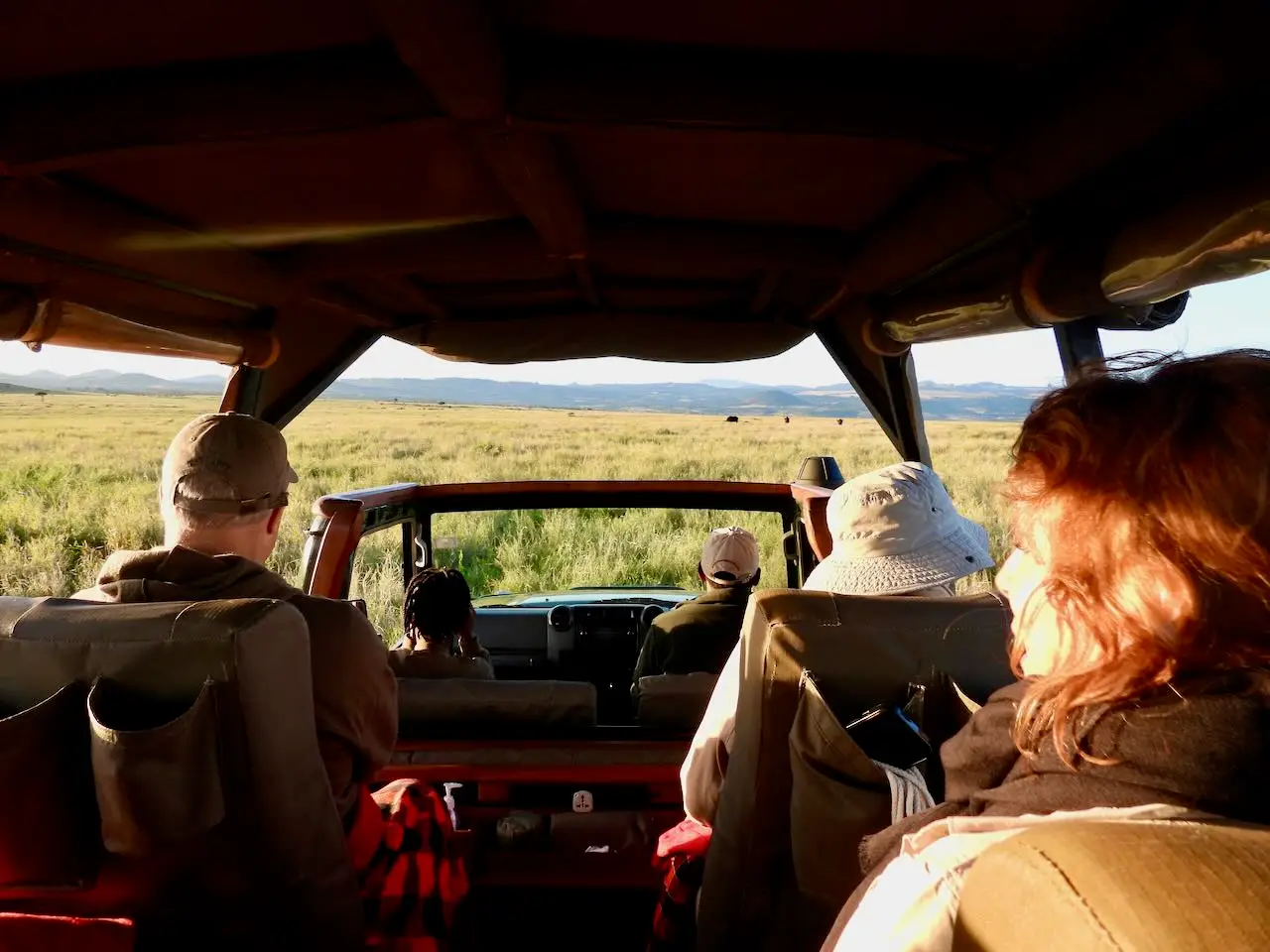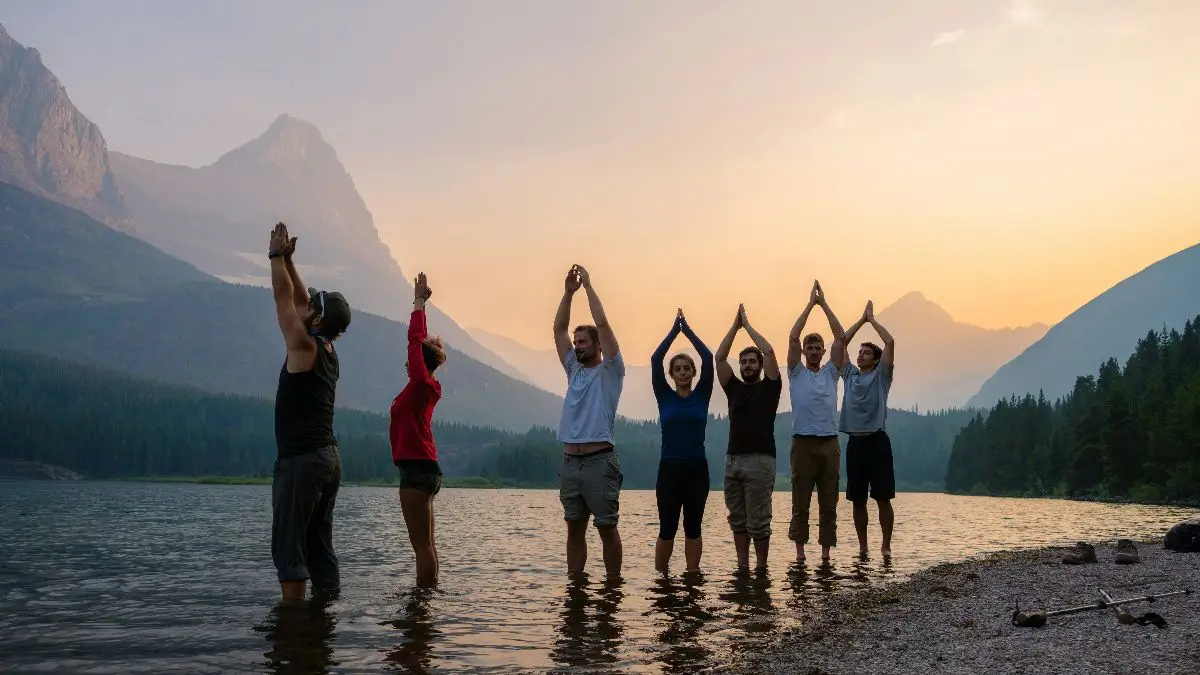Why Do Tour Operators Need Content Marketing?
1. Build brand awareness
Content marketing can attract potential customers who are not yet ready to book. And keep your brand top of mind until they’re ready. By creating and sharing valuable content (e.g., travel guides, blogs, videos, or social media posts), tour operators can increase visibility and ensure that potential customers have ongoing exposure to the brand.
The key to building brand awareness is posting interesting, engaging, original, and non-salesy content to entertain your audience and provide valuable content that builds brand awareness and loyalty. There’s a time to sell later in the customer journey but at the top of the funnel, well crafted content can be very effective in capturing attention and cutting through the noise of other brands. Providing potential customers with valuable information without a sales pitch will help them get to know you and your brand’s point of view and start to establish your brand’s credibility and authority.
Other types of content that can help people get to know and love your brand include:
- Expert interviews about the history and culture of a destination
- Behind the scenes views about a destination
- Destination guides and travel tips about a specific location
- Local’s eye views of a place
- Travel tips from staff who travel for a living
The G Adventures blog is a great example about things to do in Montenegro. It’s easy to find through search engines, gives a behind the scenes glimpse at a less-known destination, and provides valuable content that is relevant and valuable to the person. After getting this great content, a reader is more open to following G Adventures as a trusted travel resource. There are subtle links to itineraries featuring the topics discussed, but the important thing is that the content stands alone and provides value to the reader even if they don’t purchase a trip.
2. Establish trust and credibility
Sharing informative and high-quality content positions a tour operator as an industry expert and trusted partner. Customers are more likely to follow businesses that provide valuable insights, tips, and resources, making them more likely to book tours.
Content can reinforce the brand’s values by featuring content and stories that exemplify them. For example, Intrepid Travel’s blog features an article Seven Ways to Make a Difference. The article demonstrates brand values in action with ideas on how to do good when you’re traveling.
Telling stories from an external point of view is another great way to establish trust. Articles written by travelers on one of their trips are far more interesting, engaging, and believable than a boring canned testimonial. One great example is Intrepid’s experience by a mother and daughter duo that features a long and detailed daily journal of the experiences of two travelers. It’s a personal and emotional story about how a travel experience brought a family closer together.
3. Improve SEO rankings
Content marketing is crucial for improving search engine rankings. By producing keyword-rich blogs, destination guides, or FAQs, tour operators can rank higher on search engines, making it easier for potential customers to find them when searching for travel-related queries.
By attracting organic traffic, SEO-optimized content (blogs, guides, videos) helps your website rank higher on Google, bringing in more potential travelers.
4. Create demand for off-the-beaten path destinations and experiences
Producing unique content can educate and entertain your desired audience and differentiate your brand and services in a crowded market. Blogs, videos, or testimonials, can showcase the unique experiences you offer. Highlighting what sets your tours apart, such as cultural immersion, a new way to travel like a private jet, active travel experiences, wildlife expertise, or focused perspectives and experiences can attract dedicated niche audiences.
For example, Rick Steves does a great job of painting a picture of Český Krumlov, Czech Republic in a blog post that links to a tour product, a book, and a DVD for purchase. Once travelers have become interested in the history and attractions of this location through free content, they’ve already taken several steps down the path of exploration and are more likely to purchase resources or a tour from the vendor that provided this valuable content.
Contiki’s Six Two online travel magazine is a great way to capture the attention of someone who’s looking for a different travel experience. The magazine is engaging, using storytelling and highlighting interesting travel experiences. The content pulls in the audience, engages them in storytelling, then links the reader to related tours from each of the blog posts. The online magazine covers interesting topics that attract travelers looking for something different like:
- Skiing in Japan
- Real stories from real travelers
- Black history in Mexico
- A Day in the Life of an anti-poaching ranger
- Foodie finds and recipes from around the world
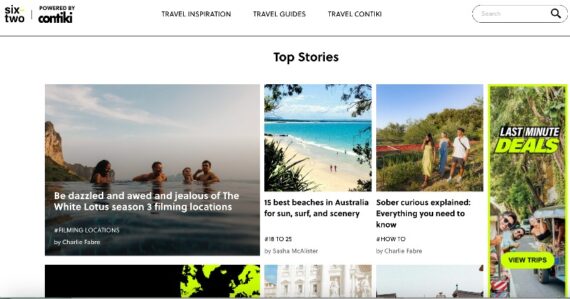
5. Engage Potential Customers
Interactive and engaging content (e.g., quizzes, polls, or behind-the-scenes videos) helps tour operators connect with their audience emotionally. This engagement builds a relationship that can influence purchasing decisions.
Trafalgar Tours has a great example of this with their Your Travel Personality Quiz. Readers take a quiz which reveals their travel personality and the types of trips that are best for that personality.
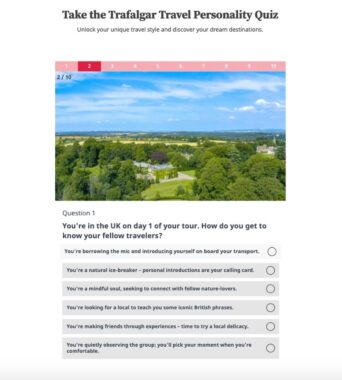
The Memory Maker? The Ice Breaker? The Connection Seeker? Answer 8 questions to reveal your travel persona, and discover the perfect tour for you.
What Trafalgar travel personality are you? Discover your perfect tour
This theme of personalization is effectively applied throughout their content. For instance, a series of blogs that match your travel personality to destinations.
Best European Summer Destinations for your Travel Personality
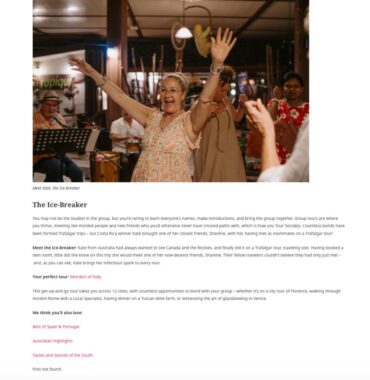
Another great example is Insight Vacations’s weekly travel trivia. It keeps users coming back to test their knowledge, and positions the tour operator as a travel authority.
6. Facilitate Bookings and faster conversion
Research indicates that travelers invest significant time and effort into online research before finalizing their travel bookings. For example, a study by Expedia Group and Luth Research found that, on average, global travelers view 141 pages of travel content in the 45 days before they actually book. This number increases to 277 pages for U.S. travelers. Additionally, travelers spend an average of over five hours (303 minutes) engaging with travel content in the time before booking. If you don’t have content to help get them ready to book, you may be missing out.
Compelling content with strong calls-to-action can hook potential customers through search, educate them, then guide them towards booking. For example, Trafalgar Tours has an Inspirations blog post about the top destinations in Europe to visit in March. The article has short descriptions of the attractions with a link to tours featuring those destinations. After finding this article through a search, readers can learn more about these top destinations, then purchase directly from the article. That’s the way to do it.
7. Enhance social media presence
Social media is the beast that is always hungry for more content. Consistently posting visually appealing and informative content helps tour operators stay top-of-mind for travelers, encouraging shares, likes, and ultimately bookings. One way to develop an effective social media presence is to establish a mission statement and channel strategy for every channel and type of content. For example, Instagram is most effective for displaying visually compelling destination and experiential content — Instagram is your “feel good” channel. Facebook could be best for sharing user-generated content, reports of trips in progress, and educational content to your followers.
Social media can be one of the most effective tools to help generate buzz for special promotions and collect user generated content.
For example, Trafalgar collected stories and photos from previous travelers through Instagram for a contest titled “Your Trafalgar Moment.” User submissions were entered into an annual contest to win a 10 day trip.
8. Foster customer loyalty
Post-tour content, such as sharing customer stories, photos, or thank-you emails, keeps the connection alive and encourages repeat bookings or word-of-mouth referrals.
I love the Explore! Four Corners Book Club where travelers can recommend a book or read recommendations for destination specific books before and after they embark on a journey. It’s engaging, it’s interesting, and it enhances the experience of travelers. And it creates a sense of community between past and future travelers, which is guaranteed to create a sense of emotional loyalty.
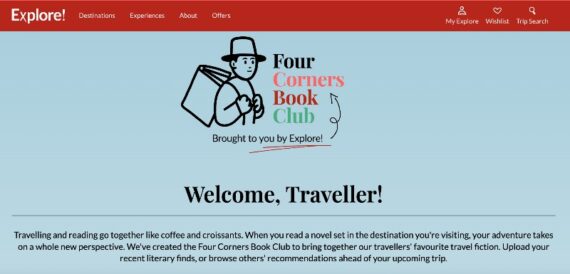
9. Educate customers
Content marketing provides an opportunity to answer common travel questions, establish trust, define your brand’s values and identity, start your role as a trusted advisor, and educate potential travelers about destinations, itineraries, and travel requirements.
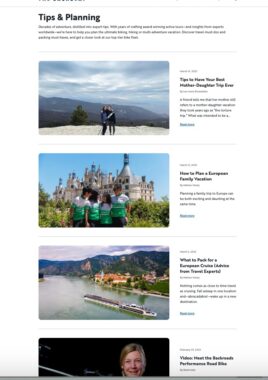
The Backroads Backbeat Blog has a robust section about travel tips and planning, where they cover information about the equipment and the traveler experience like:
- Local experience and backgrounds of the tour leaders
- Describing the Backroads experience
- Profiles of tour guides
- Stories from travelers
- What to bring on a bike ride
- Details about the bikes used on the trips
- Traveling with dietary restrictions
- Even how to enjoy a mother-daughter or a family trip
10. Demonstrate your brand’s mission and values
Content can help define and demonstrate your brand’s experience and point of view by focusing on values that differentiate your brand from your competitors. For example, as the self-proclaimed “Learning adventure company” Road Scholar’s defining brand values are learning and education. They’re currently “celebrating 50 years of learning” and they demonstrate their commitment by creating content that reinforces deep cultural education. For example, they hosted an online learning session about Leadership in Turbulent Times that highlights and reinforces the brand value and collective culture of learning that’s provided by the company even when their travelers are not on the road. They are putting their money where their mouth is and demonstrating continuity of brand express across all touchpoints including their tours and their website. In addition, the webinar topic and registration form will attract new leads and potentially new customers to the brand. And their blog features learning and educational topics like the history of interesting places like Malta, or reading lists to learn about interesting destinations.
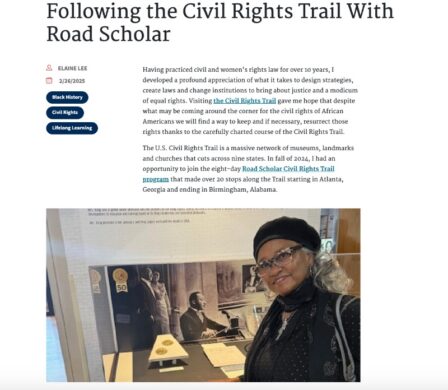
11. Articulate how your experiences are different than your competitors’
Content is one of the best places to demonstrate how your service is different than other operators. For example, when I ran the marketing department for a private jet tour operator, we wrote blog posts highlighting the behind the scenes elements of the onboard chef. For example, stories about how a top Four Seasons chef planned meals and stocked the kitchen in remote places around the world. The articles and menus demonstrated the degree of research, care, sourcing, and artistic energy that went into creating the meals and the entire customer experience.
12.Cost-effective marketing
Compared to paid ads and print brochures, digital content marketing provides long-term value by continuously attracting leads without ongoing high costs. Here’s an example of a digital prospecting strategy that’s lower cost and more effective than a typical “spray and pray” direct mail campaignTouch 1: Webinar and search Capture prospects through a free webinar or online search leading to a piece of content
Touch 2: Email On the content, prompt them to subscribe to a digital newsletter to continue the conversation
Touch 3: Email Follow up with an automated three-step drip email campaign that provides them with an engaging and interesting introduction to your brand, destinations, the sales team, and demonstrates the breadth of your offerings and services
Touch 4: Print Once they’re “warmed up” and lower in the purchase funnel and more likely to book, give them an opportunity to request a digital or print brochure for a specific itinerary. Hit them with the higher cost “big guns” after they’re already familiar with and more loyal to your brand.
- Contact us to get an integrated marketing flow customized to your company.



